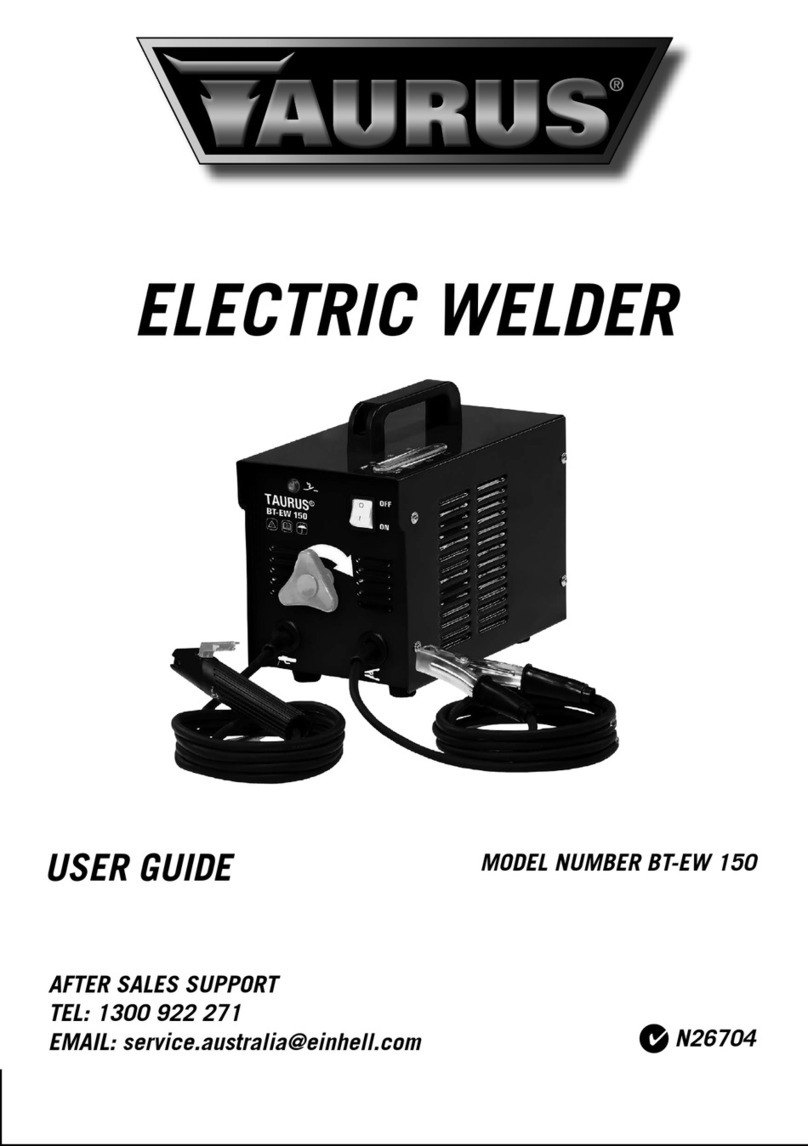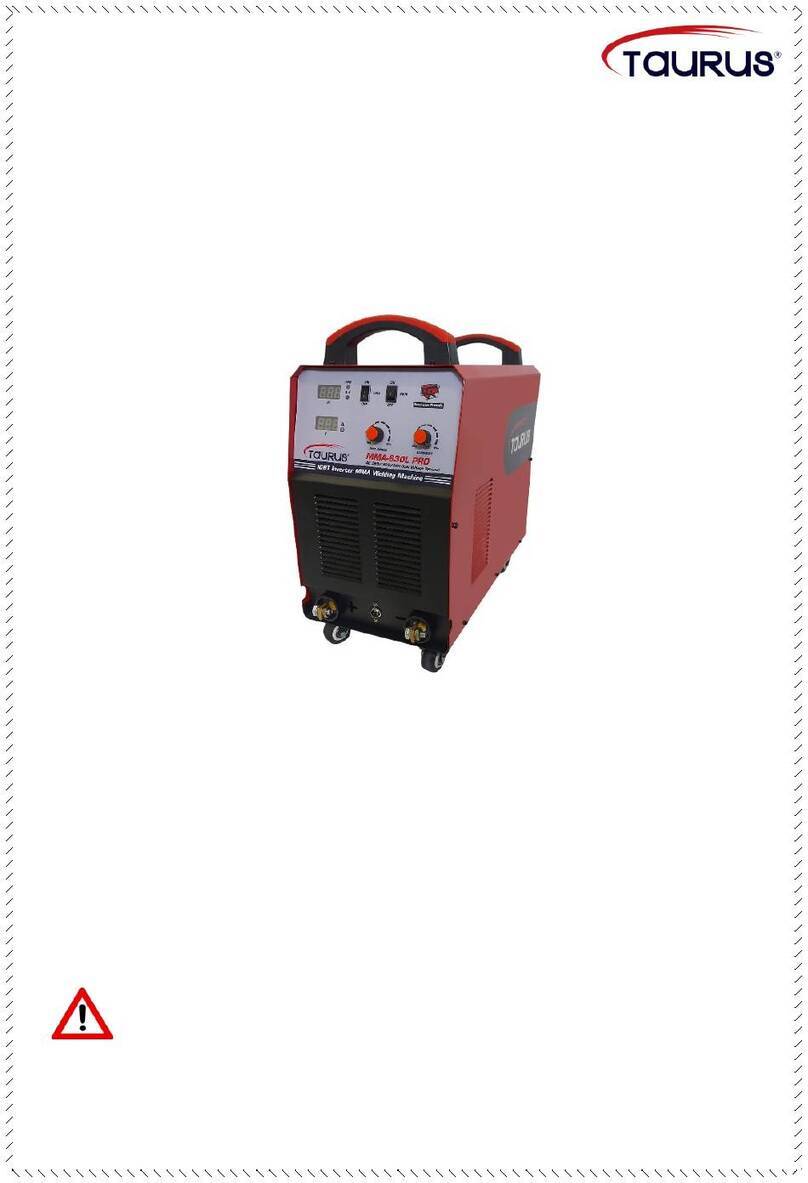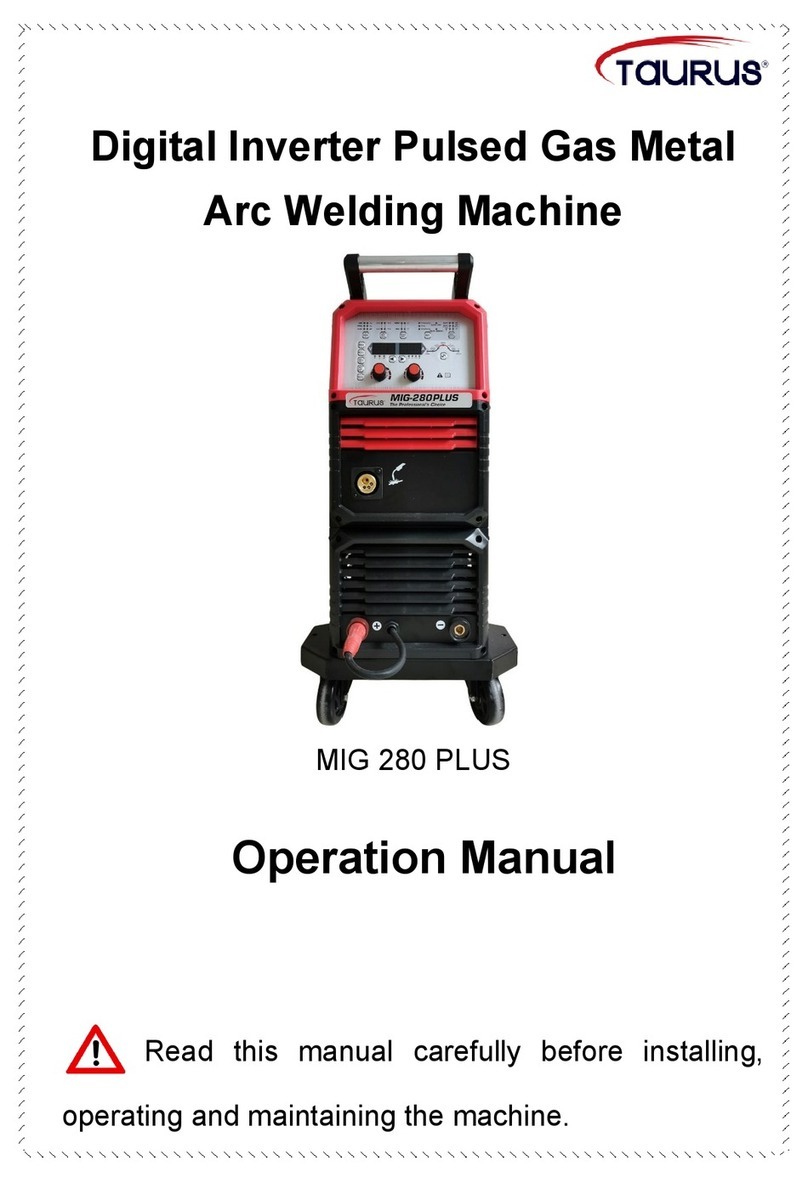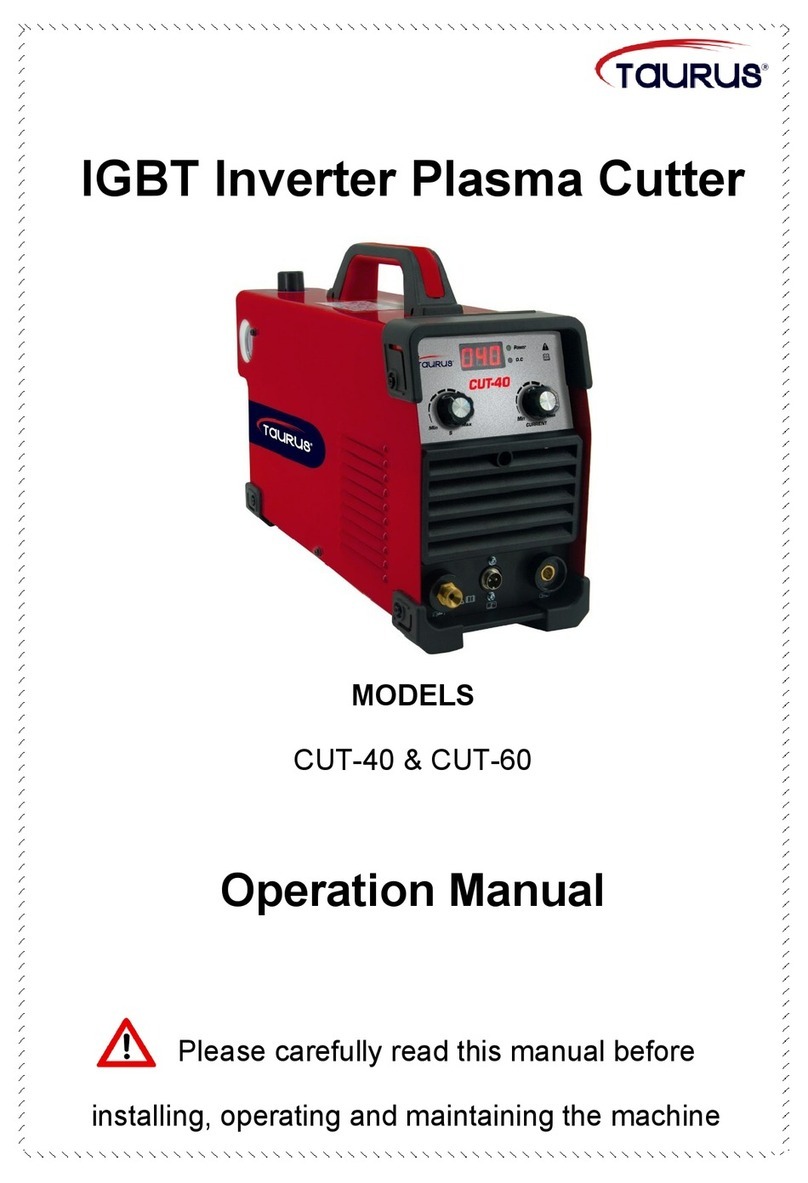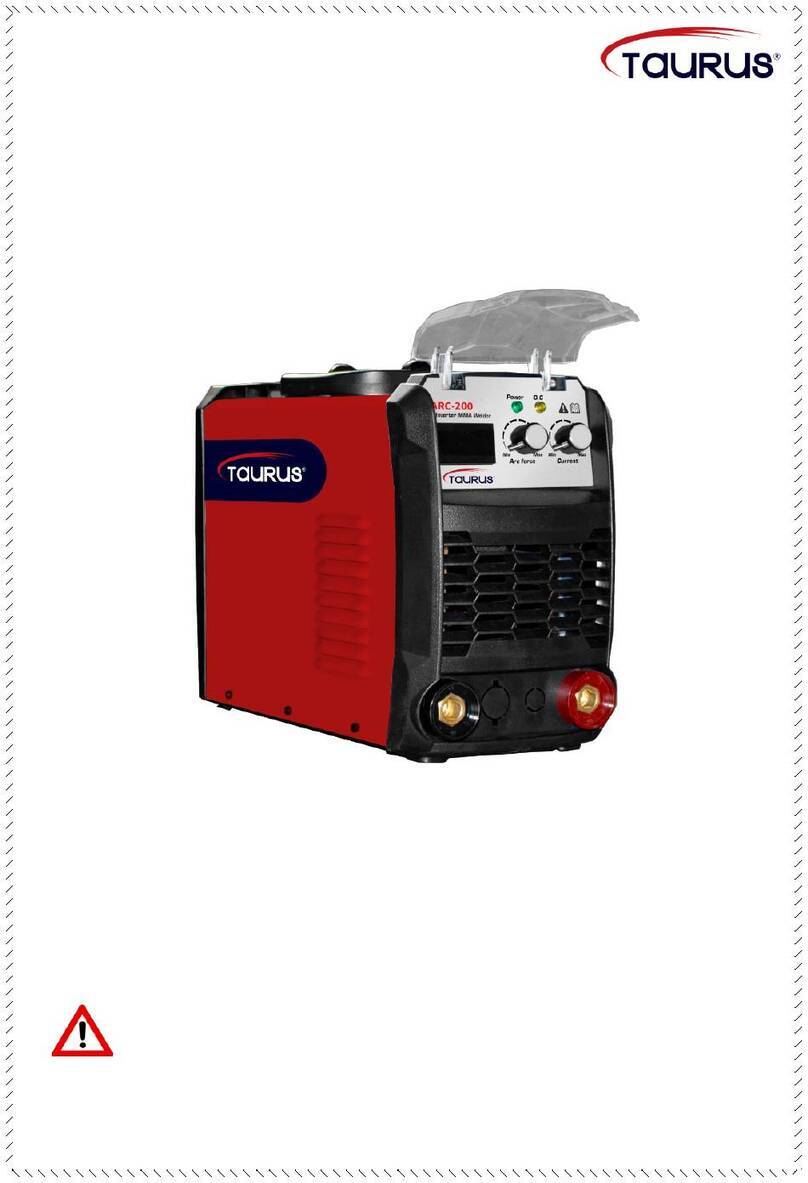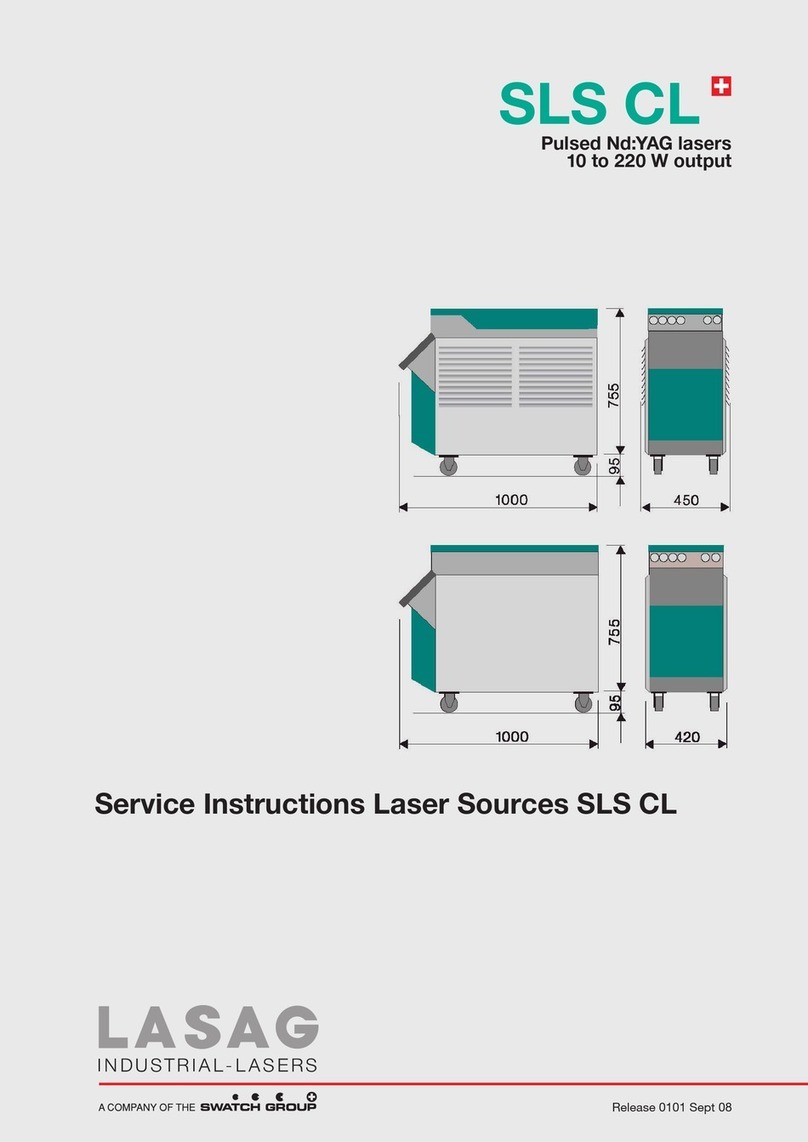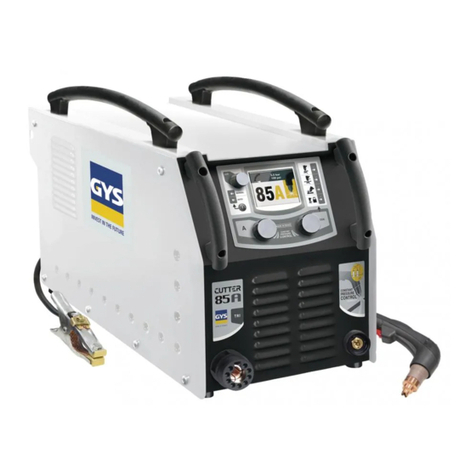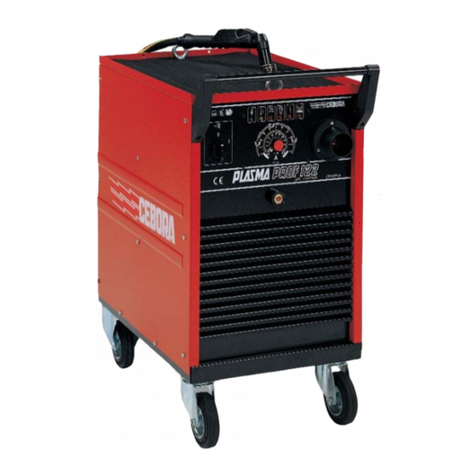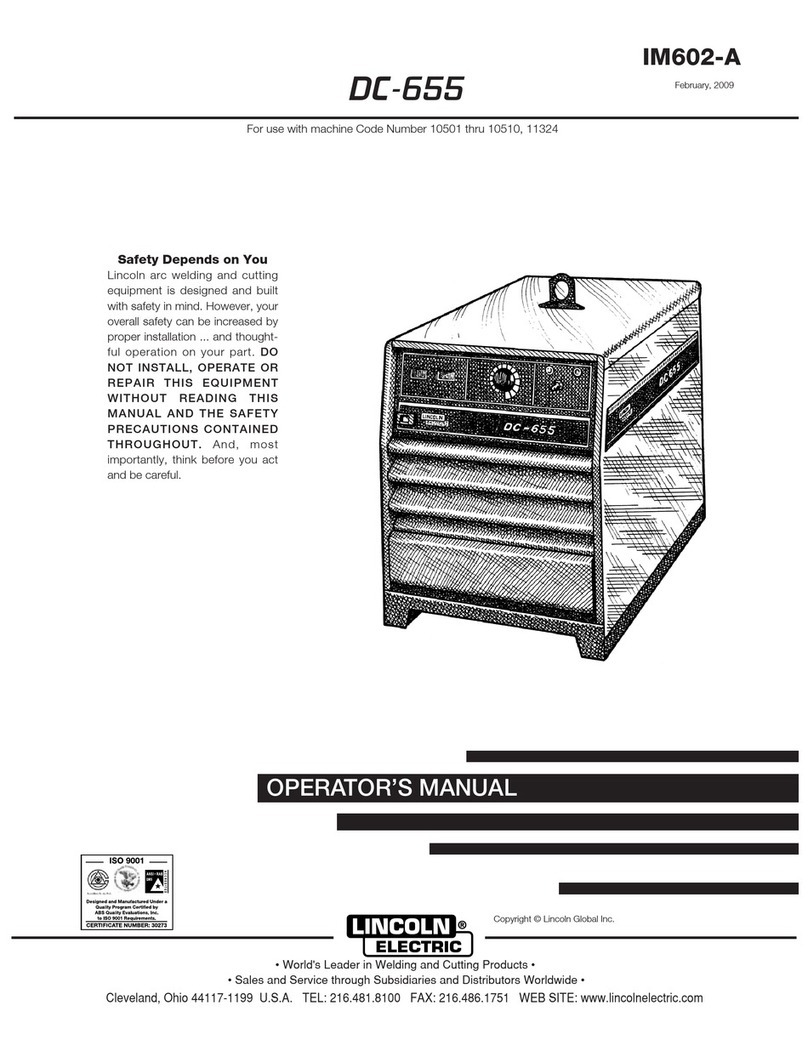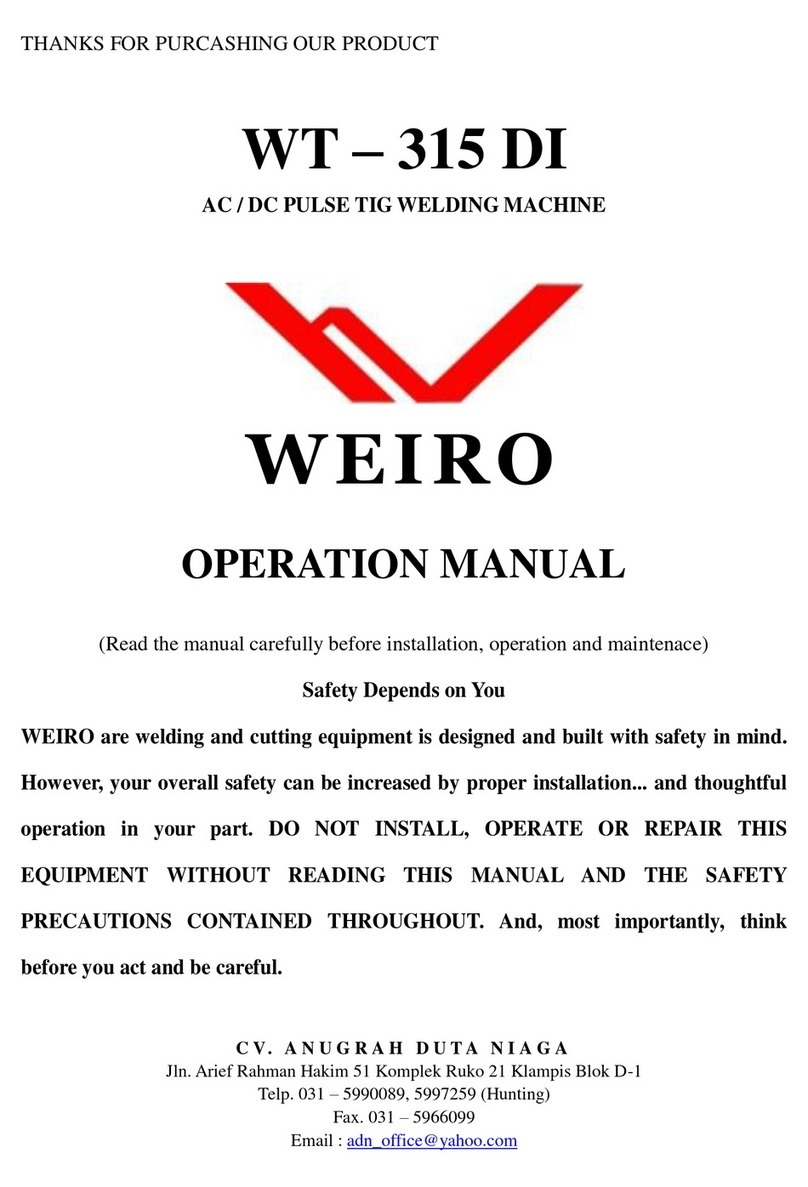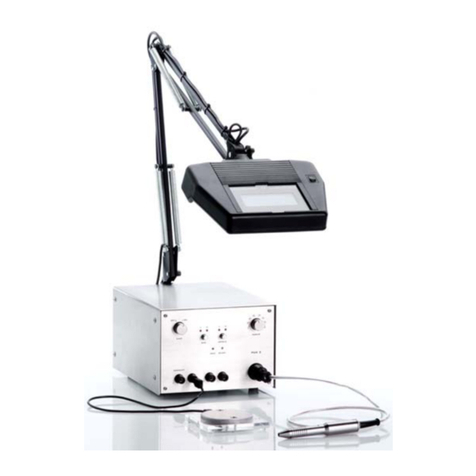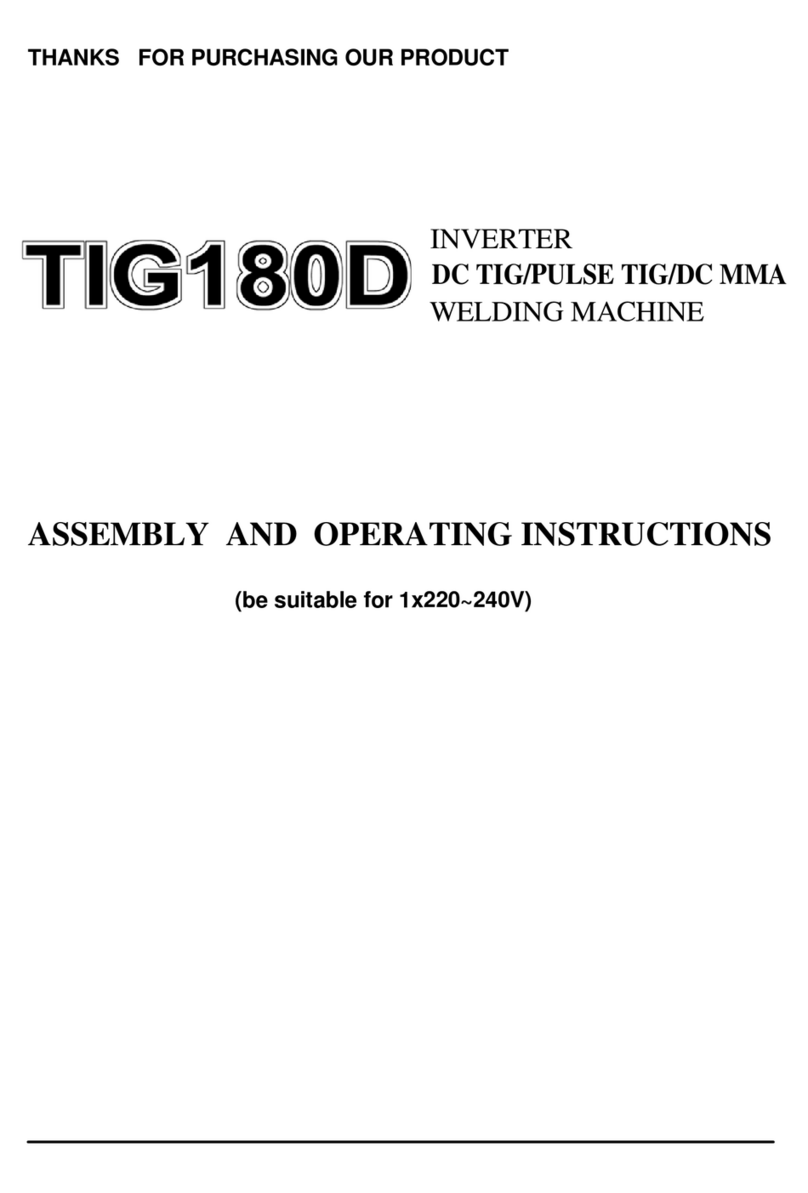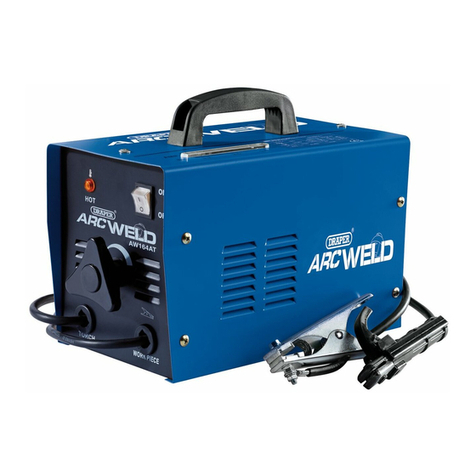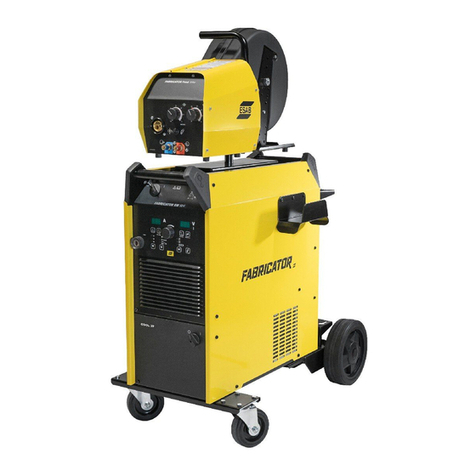Taurus MIG-350I User manual

Inverter Gas Metal Arc Welding
Machine
MODELS
MIG-350I & MIG-500I
Operation Manual
Read this manual carefully before installing,
operating and maintaining the machine.

- 1 -
Description: This machine is designed and built to weld ferrous and non-ferrous
metals.
Disclaimer: The information, illustrations and instructions described in this manual
are based on the latest product information available at the time of publication.
The manufacturer and distributors reserve the right to modify the contents of this
manual at any time. Modifications may result following product modifications and the
manufacturer and distributors are not obliged to notify any organization or individual
of such modifications. Welding work must be executed only by professionally trained
and qualified individuals. Therefore, the manufacturer and distributors will only
accept responsibility for product quality. No liability, joint or several, shall be
accepted for incidents including but not limited to loss of profit resulting from
omissions or misdirection that may be printed in this operation manual. This manual
will contain as far as possible preventive and safe operation measures related to the
equipment but cannot exclude the occurrence of accidents. Therefore, the
manufacturer and distributors shall not be liable for any direct or indirect, joint or
several liability for any incidental or consequential damages which may occur. For
detailed health and safety information, the relevant professional agencies and
manufacturers of consumables such as welding materials and flux should be
contacted.
Warranty Exclusions:
✓Consumable items such as welding wires, welding flux, fuses, quick connectors,
drive rollers, tension rollers, etc.
✓Machine damages caused by incorrect voltage input or power surges.
✓Machine or parts malfunction owing to incorrect connections or user operation.
✓Illegal disassembly or re-fitment of the machine without permission of the
manufacturer, resulting in damage or malfunction.
✓Accidental damage during shipment, transportation and storage.
✓Damage owing to incorrect handling, natural disaster and other force majeure
occurrences.

- 2 -
CONTENTS
Safety Precautions..........................................................................3
Warnings .........................................................................................4
Packaging and Transportation................................................................7
Parameter ...............................................................................................8
Product Description ................................................................................8
Working Principle..................................................................................12
Installation and Wiring ..........................................................................13
Brief Procedure for Welding Operation ................................................17
Maintenance .........................................................................................21
Common Machine Malfunctions and Solutions....................................22

- 3 -
Safety Precautions
The equipment is designed for use by qualified personnel who have completed
professional training and have obtained a qualification certificate as a welder. The
operator shall have sufficient professional knowledge of welding, cutting and circuitry.
The machine should be operated only after having read and fully understood all the
safety precautions and warnings contained in this manual and those generally
applicable to welding operations. The risk of personal injury and damage to equipment
is reduced by safety precautions being followed when using tools and equipment.
This machine is easy to operate and the selection of its functions is straight forward.
Improper use and maintenance will reduce the safe operation of the machine and the
following safety precautions must be followed:
1. The operator must be suitably qualified and certificated before operating the
equipment.
2. A qualified professional should be employed to ensure that the machine and
all cables are properly connected, grounded and installed.
3. Personal protective equipment approved by the local safety authority must
be used. All relevant safety procedures must be adhered to.
4. Before operation, insulation layers on wires and cables as well as
connection sequences should be inspected and corrected if required.
5. Repairs and maintenance should be carried out by qualified technicians only
after the machine has been disconnected from the electricity supply.
6. Operating the machine in a humid environment may result in a short circuit
or may cause an electric shock to the operator.
7. Modifications to the machine or equipment are not allowed.
8. The disposal of scrap machine parts and equipment must comply with local
regulations.

- 4 -
Warnings
Welding and cutting operations are specialised operations which present a
certain degree of risk. Professional training, correct operating procedures and
protective measures reduce the accident risk and damage to equipment.
Personal Safety Protection
Welding and cutting operations generate noise, bright light and
high-temperature sparks which will cause harm to human hearing,
eyes and skin unless personal protective measures are
implemented and proper operational instructions are adhered to.
1
Wear flame retardant personal protective equipment (PPE) such as gloves,
overalls, welding helmets with correct shading filter, shoes and aprons to
protect against thermal radiation, sparks and hot metal particles.
2
Hot sparks and metal fragments can cause skin damage. Avoid clothes with
front pockets and button-up sleeves and collars.
3
Use appropriate flame-retardant shields or curtains to protect bystanders
from arc radiation and high temperature sparks. Bystanders also need to
wear a protective helmet fitted with a shading filter to protect face and eyes
or a pair of spectacles fitted with shading filters.
4
Avoid burns and scalds by not touching a welded work piece with bare
hands.
Fire and Explosion Dangers
Welding and cutting operations generate high-temperature flames
and arc which can cause fires and explosions. The same applies to
welding slag and sparks.
1
Operators and bystanders must be protected from arc, sparks and metal
fragments.
2
The welding/cutting area should be free from flammable and explosive
materials. Should these materials be required in the welding/cutting process,
flame retardant covers should be applied.
3
Care should be taken to avoid fire hazards from cracked floors and walls.

- 5 -
4
Welding and cutting on sealed gas tanks will cause explosions. These
operations are prohibited.
5
Welding and cutting areas must be provided with adequate fire extinguishing
equipment. Regular testing for efficiency of this equipment is compulsory as
is training of staff in the use of the equipment.
6
Once the welding/cutting operation is completed, check for any high
temperature spark or metal which might cause a fire and immediately
dispose of it. If necessary, employ the assistance of a firefighter.
Electricity Hazards
Electric shock can cause serious injury or even death to the
individual when contact is made with live wires. Humid conditions
can add to the risk and great care should be taken when welding or
cutting machines are used in these conditions.
1
Reliable grounding of machine and work piece as well as a secure ground
clamp, is important.
2
Insulation layers of electric wires and cables must be checked regularly for
wear and replaced if necessary.
3
All equipment used and clothing worn during the welding/cutting operation
should be free from moist and kept dry.
4
Do not make direct body contact with any live electrical parts.
5
Wearing rubber-insulated shoes and standing on an insulated platform
greatly reduce the risk of accidental shock.
6
Refrain from replacing the ground cable on the machine with wires not
suitable for the task.
7
The machine operates on high voltage and capacitors remain charged even
after power is switched off. Removing covers for maintenance procedures
must only be executed by qualified professionals.
Effects of Electromagnetic Fields
Electric current flowing through a conductor produces magnetic
fields (EMF). The discussion on the topic of the effects of EMF on
the human body is ongoing worldwide and up to the present no
evidence has been forthcoming proving negative effects on health.

- 6 -
However, it would be wise to limit exposure to EMF as far as
possible and the following procedures are suggested:
1
Welders and cutters with cardiac pacemaker implants should obtain medical
advice on the effects of EMF on the implant.
2
Welders should minimise the possibility of electromagnetic field damage
through the following methods.
2.1
Route the electrode and ground cables together and, where possible, secure
them with tape.
2.2
Do not wrap wires and cables around arms or coil power cables around body
parts. If possible, keep cables away from the body.
2.3
Keep the distance between the ground clamp to the workpiece and the
electrode as short as possible.
2.4
Keep a safe distance between the operator and the welding/cutting machine.
Protection from Fumes and Gases
During the welding or cutting process, fumes can be produced
which may be detrimental to health.
1
The working area should be well ventilated and welding/cutting activities
should not be executed in confined spaces. Eye, nose or throat discomfort
can be the result of inadequate ventilation.
2
Welding and cutting in or near locations where chlorinated hydrocarbon
vapours are produced such as degreasing, cleaning and spraying
operations, should not be undertaken since phosgene, a highly toxic gas as
well as other irritants can be reaction products.
3
The industry offers a variety of respiratory masks and must be used in
conditions where clean breathing air is required.
Gas Cylinder Safety
Gas leaks can occur on cylinders connected to welding/cutting
operations if the system is not properly managed and maintained.
A ruptured cylinder or relief valve can cause serious injury or can
even be fatal.

- 7 -
1
Gas cylinders should be kept away from extreme temperatures and fire
sources. Scratching on cylinder walls with hard objects should be avoided.
2
A flowmeter should be installed on the gas cylinder in use in accordance with
the manufacturer's operating instructions. Quick-coupling connectors must
not be used and gas hose fitting should be tested for leaks.
3
Gas cylinders must always be kept upright and chained or belted to a
cylinder trolley, base, wall, post or shelf. Never fix a gas cylinder to a
worktable or machine: It can become party to an electrical circuit and
explode.
4
Ensure that the cylinder valve is closed when not in use. If there is no hose
connected to the flowmeter then cover the outlet with a dust cap.
Protection Against Moving and Rotating Parts
Moving parts, such as fans, rotors and belts, can be
hazardous.
1
Ensure that all protective covers, doors and panels on the machine are
closed or securely intact before starting an operation.
2
Ensure that maintenance on machines are only carried out by qualified
technicians.
3
Ensure that hands, hair, clothing and tools are safely out of range from
moving and rotating parts.
Packaging and Transportation
1. Pay attention to and comply with packaging, storage and transportation
instructions which are clearly identified on the containers.
2. Always handle all containers with care.
3. Equipment must be stored in waterproof, moisture proof and well-ventilated
facilities within the temperature range -25°C - 55°C.

- 8 -
Parameters
Product Description
The welding machine in this series inverts the 50Hz power supply to a
high-frequency, high-voltage power supply. The inversion process is facilitated
by a powerful IGBT device followed by step-down rectification and pulse-width
modulation (PWM) technology producing a high-power DC output suitable for
welding. The advanced inverter technology allows for the construction of a
smaller volume and light-weight, stable and reliable transformer with a 30%
improved efficiency. Added to the advantages of the inverted power supply, the
Model
MIG-350I
MIG-500I
Item
Value
Rated input voltage:
3PH AC380V±15% 50/60Hz
Rated input power:
15KVA
25KVA
Rated input current:
22.8A
38.5A
Rated duty cycle:
60%
Output current range:
60A-350A
60A-500A
Open circuit voltage:
67V
70V
Efficiency:
≥85%
Wire diameter (mm):
Ф0.8~Ф1.2
Ф0.8~Ф1.6
Wire Feeding Speed:
2~18M/min
2~18M/min
IP grade:
IP21S
Insulation grade:
F
Package dimensions (mm):
710*385*680
(main body)
565*275*392
(wire feeder)
740*405*710
(main body)
565*275*392
(wire feeder)
G.W.:
18kg(main body)
28kg(wire feeder)
20kg(main body)
37kg(wire feeder)

- 9 -
machine has good dynamic characteristics, and offers a stable arc, good welding
quality and ease of control.
This semi-automatic, high-performance machine is designed for CO2 and
mixed-gas welding on low-carbon steel, low-alloy steel, stainless steel,
galvanized sheet and copper. Steel and stainless steel wire as well as other
solid wires with diameter Φ0.8 - Φ1.6mm can be used.
The inverter welding machines in this series are manufactured in accordance
with IEC60974-1 <Arc Welding Equipment - Part 1: Welding Power Sources >,
Safety Requirements for Arc Welding Equipment.
1. Product Functions and Features:
1.1. All-in-one multiple welding functions served by a digital CPU control system
delivering a precise digital output.
1.2. High efficiency and duty cycle and a noiseless rectifier.
1.3. A stable welding process and excellent arc self regulation is ensured by the
closed-loop control system regulating a stable voltage in cases of
grid-voltage fluctuation.
1.4. Less spatter and a high metal-deposition rate as well as excellent
weld-seam appearance and low metal distortian.
1.5. The self-locking function greatly reduces operator fatigue owing to extended
welding operations.
1.6. The MMA function allows the use of a variety of different diameter
electrodes such as acid, alkaline, stainless steel, and cast iron.
1.7. Troubleshooting is minimised by the protection circuit ensuring safety and
reliability.
1.8. The IP21S protection level ensures reliability even in harsh environments.

- 10 -
2. Appearance Diagram:
MIG-350I/500I
Panel:
1
Welding mode button: Selects between MIG and MAG and operates
when the corresponding light is lit.
2
Inching wire feeding button: Button pressed starts wire feed. Button
pressed again stops wire feed.
3
Crater current adjustment: Rotate the knob to adjust the crater current.
4
Wire feeder control socket: Connection socket for the wire feeder
control cable.
6
1
3
1
1
1
2
3
1
7
1
8
1
9
1
10
1
1
3
1
2
1
9
1
5
1
4
1
8
1
6
1
7
1

- 11 -
5
+
10
Terminal sockets - positive pole (+) and negative pole (-): In MMA
mode the electrode holder cable is connected to the positive terminal
and the earth cable is connected to the negative terminal and should be
reversed when using scratch start DC TIG in MMA mode. In MIG mode
the polarity cable is connected to the positive terminal and the earth
cable is connected to the negative terminal for all MIG welding
applications, except for gasless flux-core welding where the polarity
cable is reversed and connected to the negative terminal and the earth
cable is connected to the positive terminal.
6
Push-button trigger mode: Switch between 2T and 4T trigger modes
and operate when the corresponding light is lit.
7
Gas:Press and hold the gas button to start the gas flow inspection.
Releasing the button will stop the gas flow.
8
Induction adjustment: Rotate the knob to adjust inductance and
regulating arc intensity.
9
Crater voltage adjustment: Rotate the knob to adjust crater voltage.
3. Setting the Trigger Mode
3.1. 2T Mode
This setting applies for short-spell welds and the responding current curve is
depicted below.
0~t1: Press torch trigger. Gas pre-flow starts.
t1~t2: Wire feed starts. Gas flows.
t2: Welding operation starts and current reaches preset value.

- 12 -
t3~t4: Trigger released. Wire feeding stops and current drops to zero.
Post-flow gas will continue for a short period. Note: the gas pre-flow and
post-flow not adjustable in T2 mode.
3.2. 4T Mode
This setting applies for longer-spell welds and the responding current curve is
depicted below.
0~t1:Press torch trigger. Gas pre-flow starts.
t1~t2:Release the trigger and the wire feed starts and current reaches
preset value.
t2~t3:Pressing the trigger again, stops the wire feeding and drops the
current to zero. Post-flow gas will continue for a short period.
Working Principle
1. Diagram Explaining Working Principle
1.1. A bridge rectifier converts AC to DC;
1.2. After secondary rectification and reactor filtering, output welding current is
delivered that meets the welding requirements;
1.3. Controlled by PWM the IGBT inverts the DC to 20KHz AC which is
transmitted via a high-frequency transformer;

- 13 -
1.4. The in-time protection circuit provides signals to the PWM warning for
overheat and over-current situations;
1.5. A closed-loop control system ensures a good anti-grid fluctuation ability and
an excellent cutting performance.
Installation and Wiring
1. Location Requirements
1.1. The machine should not be installed in an area where it is exposed to direct
sunlight or rain but where the humidity is as low as possible and the ambient
temperature is within the range of -10°C - 40°C.
1.2. The machine should be installed on a flat, preferable level surface but, in
any case not on a surface with an inclination of more than 10 °.
1.3. The machine should not be operated in a work station exposed to wind.
Should a windy environment be unavoidable, suitable screening should be
installed.
1.4. In order to allow for efficient ventilation, a clear space of at least 20cm
should be allowed in front of and behind the machine as well as at least
10cm at each side.
2. Power input requirements
The power supply waveform should be the standard sin wave, the rated voltage
380V±10% 50/60Hz. Three phase voltage unbalance should be ≤5%.
.
Model
MIG-350I
MIG-500I
Parameters
Value
Power supply:
3PH-AC380V±15% 50/60Hz
Rated input current:
22.8A
38.5A
Input cable:
≥4.0mm2
≥4.0mm2
Output cable:
35mm2
50mm2
Ground cable:
≥4.0mm2
≥4.0mm2

- 14 -
3. Main Power Supply Connection
Pay attention to prevent electric shock
Wear goggles
Take note of the following when the machine is connected to the main
power supply:
3.1. The connection must be carried out by a qualified electrician or technician.
3.2. The connection must be in compliance with national and local regulations.
3.3. Before the connection is carried out, the main power supply to the control
box must be switched off.
3.4. An earth cable set must be securely connected from the machine to the
work-piece. The machine must be earthed.
3.5. Ensure that the required power supply of the machine (as printed on its
nameplate) corresponds to the main power supply.
3.6. The connection screws on the terminal block must be tight ensuring a solid
connection between the machine cable wires and the main power supply.
3.7. The correct wiring procedure is explained in the following diagram:
Wiring of Three Phase AC, 50/60Hz Welding Machine
2b
3
7
6
4
4
5
1
2c
2d
2a

- 15 -
No.
Item
No.
Item
1
Power cord
3
Terminal block
2a
Live wire L1
4
Overcurrent protection device
2b
Live wire L2
5
GND
2c
Live wire L3
6
Earth wire terminal block
2d
Earth wire
7
Electric control box
4. Gas-cylinder Connection
Explosion hazard
Prevent gas
inhalation
Wear goggles
Warning: The following safety instructions are important when connecting
a gas cylinder to the welding machine.
4.1. The cylinder must be fixed to a wall, cylinder rack or support. Its centre of
gravity can cause the cylinder to topple resulting in injury and material
damage.
4.2. The cylinder must be placed out of reach of the operator's welding station
and not in contact with the work table or the welding machine.
4.3. Connect the gas hose firmly from the flowmeter outlet to the gas inlet
situated at the back of the welding machine. Gas leakage is not allowed.
4.4. Adjust the flowrate in accordance with the manufacturer's recommendation.
Generally, 15 -20 litres/min.

- 16 -
5. Wirefeeder
5.1. Selection of Tension Roller and Drive Roll
Non-groove
Non-groove
Tensioner roller
Drive roll
V groove
knurled
V groove roll
Suited for hard wires such as solid carbon steel
and stainless-steel wires.
Knurled roll
Suited for flux-cored wires.
5.2. Wire-feed Pressure Selection
The wire-feed pressure scale is etched on the pressure-regulating handle and
prescribes the approximate pressure scale to be selected for use on different
wire materials and diameters.
Scale Table
Diameter
Pressure
Drive roll
Ø0.8mm
Ø1.0mm
Ø1.2mm
V groove roll
3
3
2.5
Pressure scale
Knurled roll
-
1.5
2
The actual pressure scale to be used will be determined by the length of the
torch cable, the type of welding torch and welding wire as well as wire-feeding
conditions. After adjustment of the drive roll, press the tensioner roller. Should
the wire slip when exiting the contact tip, readjust.
!However:
◆Take care not to apply excessive pressure which will result in wire being
deformed and coatings being damaged.
◆Excessive pressure will also result in faster drive-roll wear.

- 17 -
6. Installation of Wire Liner and MIG Torch
In order to deliver a smooth and successful welding job, it is important to confirm
that the wire liner and contact tip is compatible with the welding torch and that
the wire liner is suitable for the diameter and type of wire to be used.
7. Installation and Adjustment of Welding wire
Prevent injuries
caused by wire
Prevent injuries caused
by moving parts
Wear goggles
!Attention:
◆The wire speed generated by the feeder is relatively fast and safety
during the installation and adjustment process is of prime importance.
Never point the welding torch nozzle to a face or other body part. The
speed of the wire exiting the nozzle can cause a nasty jab.
Brief Procedure for the welding operation
1. Procedure for MIG Welding
1.1. Wear the necessary welding protection equipment such as helmet, mask,
earplugs, protective clothing, gloves, insulating safety shoes.
1.2. Confirm the electrical grid connected to the welding machine is consistent
with the correct power supply of the machine.
1.3. Confirm that the insulation layers on all the wires and cables of the
welding machine are intact and that the cable set is secure and correctly
connected to the machine.
1.4. Confirm the machine is freely vented and that the vents on the machine
are not obstructed and no objects are lying on the machine body.
1.5. Connect and tighten the earth cable to the negative pole. Clamp the other
end of the cable to the workpiece.
1.6. Connect and tighten the welding(polarity) cable of the wire feeder to the
positive pole.

- 18 -
1.7. Connect and tighten the wire feeder control cable to the aviation socket.
1.8. Connect the wire-feeder gas hose to the flowmeter. If the flowmeter has a
heating power cable, then connect it to the heating power supply socket
on the rear of the machine.
1.9. Connect the MIG torch to the Euro socket adaptor on the wire feeder and
tighten the connection nut.
1.10. Switch on the machine and ensure the indicator light is lit and the fan is
operational. Open the gas valve on the cylinder and regulate the gas flow
to the required flow rate.
1.11. Ensure that the locating hole on the wire spool corresponds with the
locating pin on the hub, install the wire spool on the hub shaft and lock the
spool with the hub nut.
1.12. Ensure that the groove position of the wire feeding roller and the diameter
of the nozzle are compatible with the wire diameter.
1.13. Release the wire feed pressure and direct the welding wire into the groove
of the wire feeding roller, through the wire guide tube into the wire guide
tube of the central socket.
1.14. Adjust the pressure to the point where wire does not slip or the wire is
deformed by a too high pressure.
1.15. Press the inching wire feed switch allowing the wire to be fed through the
torch until it protrudes the required length from the nozzle.
1.16. Set the required parameters for the job at hand. To start the welding
operation, press the torch trigger.
1.17. During the welding operation, the parameters can be modified to suit the
situation.
1.18. After welding operation is completed, switch off the power on the machine
and distribution box.
2. MMA Welding Operation Procedure
2.1. Wear the necessary welding protection equipment such as helmet, mask,
earplug, protective clothing, gloves, insulating safety shoes.
2.2. Confirm the electrical grid connected to the welding machine is consistent
with the correct power supply of the machine.

- 19 -
2.3. Confirm that the insulation layers on all the wires and cables of the
welding machine are intact and that the cable set is secure and correctly
connected to the machine.
2.4. Confirm the machine is freely vented and that the vents on the machine
are not obstructed and no objects are lying on the machine body.
2.5. Connect and tighten the earth cable to the negative pole. Clamp the other
end of the cable to the workpiece.
2.6. Connect and tighten the welding cable to the positive pole. Use the
electrode holder to clamp the electrode.
2.7. Switch on the machine and ensure the indicator light is lit and the fan is
operational.
2.8. Select the MMA mode on the front panel. Preset the welding current in
accordance with the specifications of the welding electrodes.
2.9. During the welding operation the parameters can be modified to suit the
situation.
2.10. After welding operation is completed, switch off the power on the machine
and distribution box.
3. Suggested Settings for MIG Welding
Welding current range
(A)
Welding Voltage range
(V)
Wire diameter
(mm)
60~80
17~18
Ф1.0
80~130
18~21
Ф1.0、Ф1.2
130~200
20~24
Ф1.0、Ф1.2
200~250
24~27
Ф1.0、Ф1.2
250~350
26~32
Ф1.2、Ф1.6
350~500
31~39
Ф1.6
This manual suits for next models
1
Table of contents
Other Taurus Welding System manuals
Popular Welding System manuals by other brands
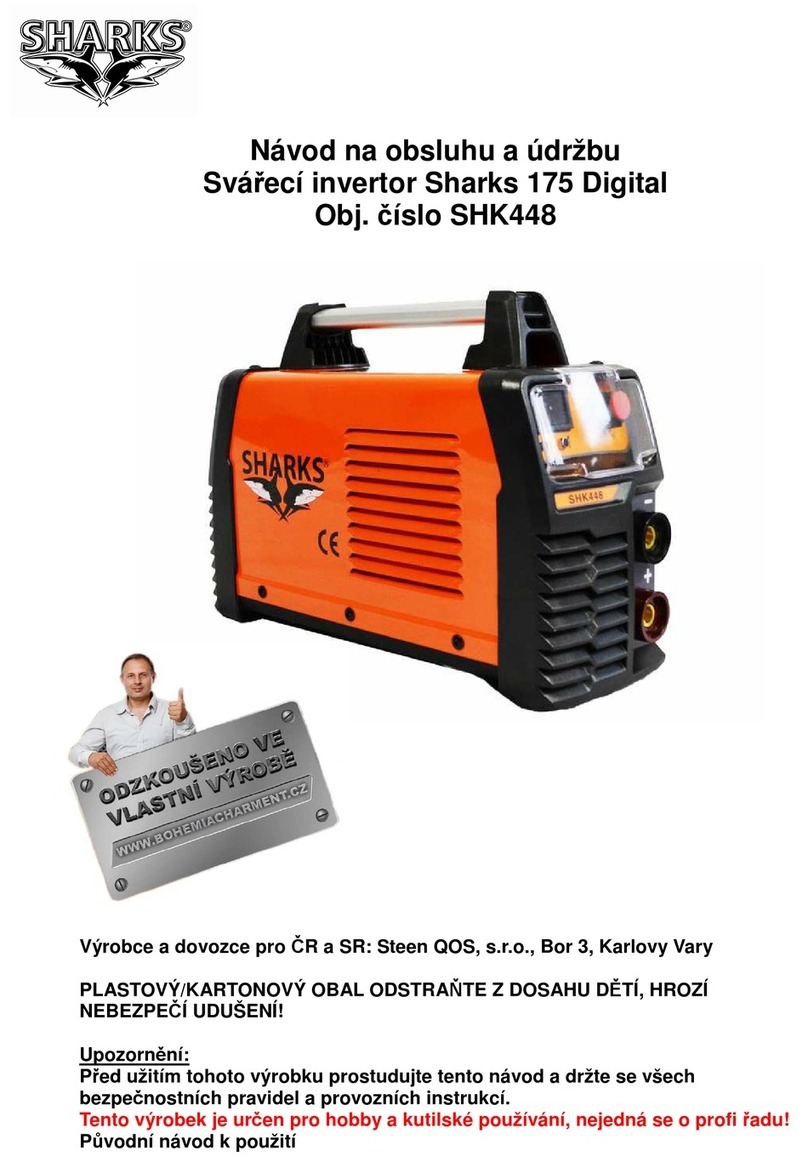
SHARKS
SHARKS 175 Digital Instruction for operation and maintenance
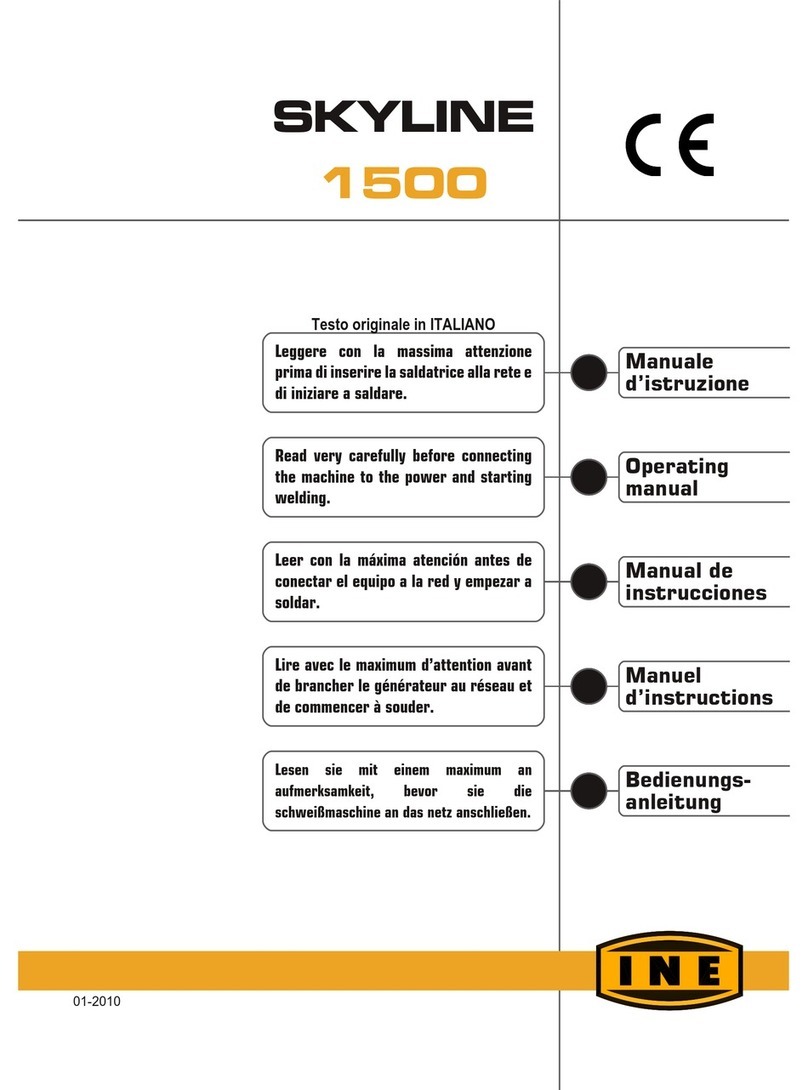
SkyLine
SkyLine 1500 operating manual

Lincoln Electric
Lincoln Electric INVERTEC V311-T AC/DC Operator's manual

Hypertherm
Hypertherm powermax 380 Operator's manual

Razorweld
Razorweld KUMJRRW145 operating manual
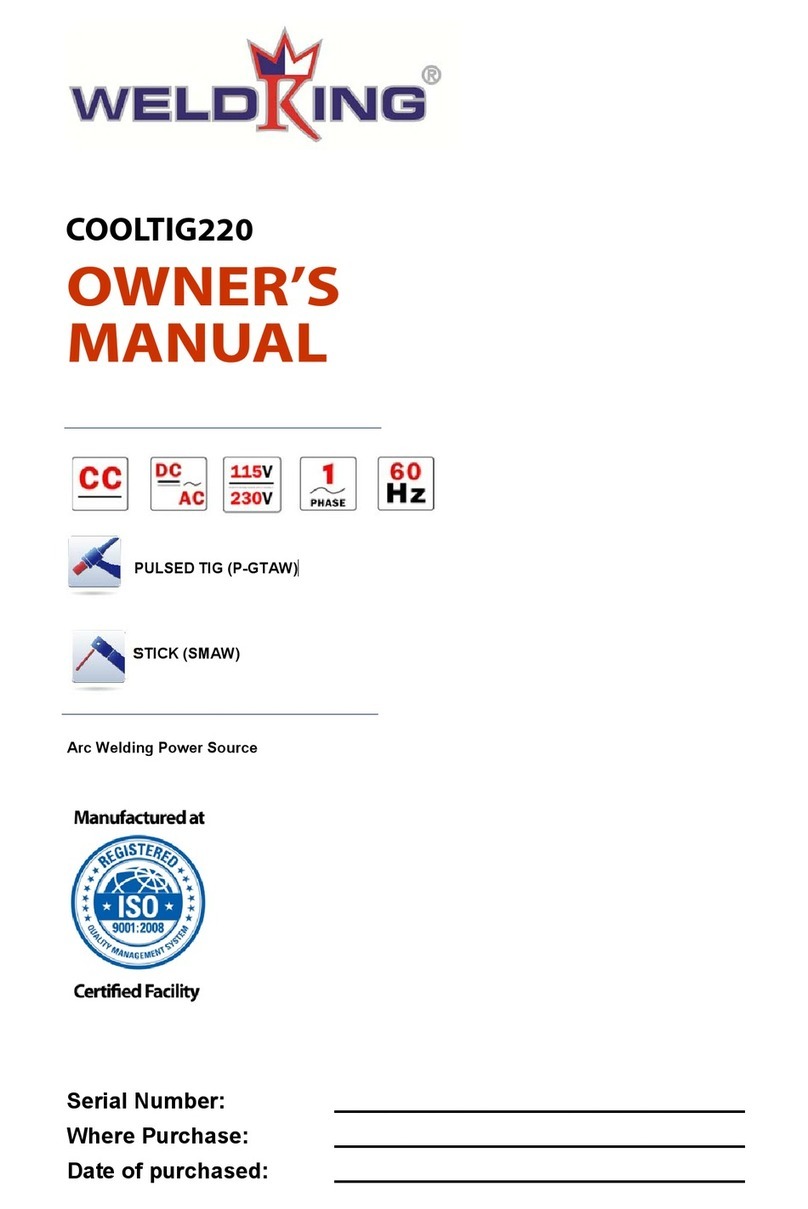
WeldKing
WeldKing COOLTIG220 owner's manual
